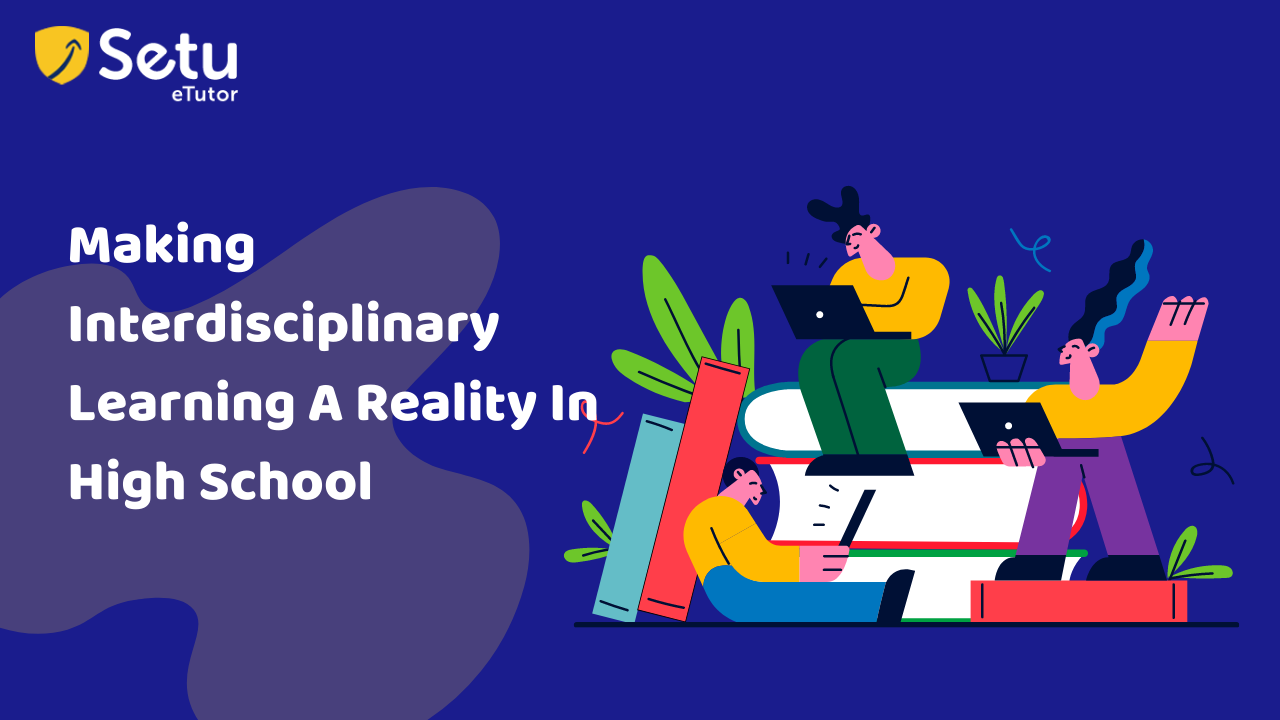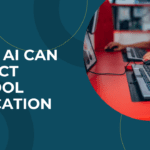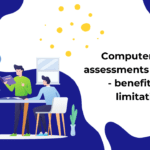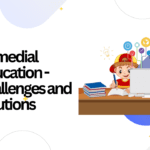Table of contents
Introduction
Interdisciplinary learning
Benefits students can get from Interdisciplinary learning
Implementation Strategies of Interdisciplinary Learning
How SETU supports students in attaining interdisciplinary learning?
Conclusion
Introduction:
There are hundreds of problems and challenges that students face in their day-to-day lives. By connecting all the elements in the universe together, a result-oriented solution can be drawn.
Similarly, in today’s interconnected world, where complex challenges require innovative solutions, interdisciplinary learning has emerged as a powerful approach to education.
Preparing students for the challenges of the future requires an education that mirrors the interconnectedness of the world they will inhabit.
Imagine a group of high school students embarking on a project to address food insecurity in their community. As they delve into the issue, they realize that it encompasses more than just hunger. To design a sustainable solution, they must explore agriculture, nutrition, economics, sociology, and environmental studies.
By engaging in interdisciplinary learning, these students gain a holistic understanding of the problem, allowing them to develop creative strategies that consider the interconnectedness of various factors.
Through interdisciplinary learning, students are encouraged to step beyond the boundaries of traditional subjects and explore the intersections between different disciplines. They become active learners, engaging in critical thinking, problem-solving, and collaboration.
In the example of tackling food insecurity, students might analyze the economic factors that contribute to limited access to nutritious food, study agricultural techniques that maximize yield and sustainability, examine the sociological implications of hunger, and explore the environmental impact of food production and waste.
By embracing interdisciplinary learning, students develop a comprehensive set of skills and knowledge that extends beyond memorizing isolated facts. They learn to think critically, considering multiple perspectives and integrating diverse ideas. They also foster creativity as they explore innovative approaches that draw upon the strengths of various disciplines. Additionally, interdisciplinary learning cultivates collaboration and communication skills, as students collaborate with peers, experts, and community members to address complex real-world problems.
In this article, we are going to explore how interdisciplinary learning benefits students and what strategies need to be implemented to achieve it.
Interdisciplinary learning
Interdisciplinary learning provides a pathway for students to develop the adaptability, versatility, and critical thinking skills needed to thrive in diverse fields and industries. By connecting learning to real-world examples, students understand the relevance and practical applications of their education, empowering them to make a meaningful impact in their communities and beyond.
Benefits students get from Interdisciplinary learning:

Students can derive numerous benefits from interdisciplinary learning, including:
- Holistic Understanding: Interdisciplinary learning enables students to develop a comprehensive understanding of complex topics by exploring connections between different disciplines. They gain insights into how various subjects intersect and contribute to a broader understanding of real-world issues.
- Critical Thinking Skills: Interdisciplinary learning fosters critical thinking skills as students analyze problems from multiple perspectives. They learn to evaluate evidence, consider diverse viewpoints, and develop well-rounded and informed opinions.
- Creativity and Innovation: By integrating knowledge from different disciplines, students are encouraged to think creatively and develop innovative solutions. They learn to think outside the box, combining ideas from various fields to address complex challenges.
- Problem-solving Abilities: Interdisciplinary learning equips students with problem-solving skills that transcend disciplinary boundaries. They develop the ability to identify and tackle complex problems using multidimensional approaches, drawing on diverse knowledge and methodologies.
- Collaboration and Communication: Interdisciplinary projects often require students to collaborate with peers from different backgrounds. This promotes effective communication, teamwork, and the ability to work harmoniously in diverse groups, mirroring real-world professional environments.
- Real-world Relevance: Interdisciplinary learning connects academic concepts to real-world applications, enhancing students’ understanding of how knowledge can be applied in practical contexts. This prepares them for future careers where they may need to navigate interdisciplinary challenges.
- Versatility and Adaptability: Interdisciplinary learning cultivates versatile and adaptable learners who can apply their knowledge and skills in a variety of contexts. They become comfortable navigating complexity, embracing ambiguity, and seeking innovative solutions.
- Global Perspective: Interdisciplinary learning encourages students to consider global issues, diverse cultures, and different perspectives. They develop a broader worldview, promoting empathy, cultural sensitivity, and the ability to engage with global challenges as responsible citizens.
- Lifelong Learning Mindset: Interdisciplinary learning nurtures a love for learning and a curiosity that extends beyond traditional disciplinary boundaries. Students become lifelong learners, continuously seeking connections and expanding their knowledge across various disciplines.
By engaging in interdisciplinary learning, students gain a well-rounded education that prepares them for the complexities of the modern world, equipping them with valuable skills and perspectives for their future endeavors.
Implementation Strategies of Interdisciplinary Learning:
Teachers can adopt various strategies to effectively implement interdisciplinary learning through:
- Collaborative Planning: Teachers from different disciplines collaborate to plan and design interdisciplinary units or projects. They align learning objectives, identify connections between subjects, and determine how different disciplines can contribute to a holistic learning experience.
- Integration of Subjects: Teachers intentionally weave together content from different subjects to create a cohesive learning experience. They identify common themes or concepts that can be explored through multiple disciplines, ensuring that each subject contributes meaningfully to the overall understanding of the topic.
- Team Teaching: Teachers from different disciplines co-teach during interdisciplinary units. They combine their expertise and perspectives, sharing responsibility for delivering content and facilitating student learning. This collaboration enhances the integration of subjects and provides students with diverse insights.
- Project-Based Learning: Teachers design interdisciplinary projects that require students to apply knowledge and skills from multiple disciplines to solve real-world problems or explore complex topics. These projects promote critical thinking, collaboration, and creativity while allowing students to make connections across subjects.
- Authentic Assessment: Teachers employ assessment strategies that align with interdisciplinary learning objectives. They use rubrics, portfolios, presentations, or performance-based assessments to evaluate students’ interdisciplinary understanding, application of knowledge, and skills development.
- Flexible Grouping: Teachers organize students into diverse groups, encouraging collaboration and cooperation among students with different strengths and perspectives. This fosters the exchange of ideas and allows students to learn from one another’s disciplinary expertise.
- Reflection and Metacognition: Teachers facilitate opportunities for students to reflect on their learning experiences, make connections between disciplines, and think critically about their interdisciplinary knowledge and skills. Reflective activities promote metacognition and help students understand the value of interdisciplinary learning.
- Professional Development: Teachers engage in professional development opportunities that focus on interdisciplinary teaching strategies, curriculum design, and collaboration with colleagues. Continuous learning and sharing of best practices support the effective implementation of interdisciplinary learning.
- Community Partnerships: Teachers establish partnerships with organizations, experts, or community members relevant to the interdisciplinary topic. These partnerships provide students with authentic connections to the real world and expand their understanding of interdisciplinary concepts.
- Ongoing Reflection and Adaptation: Teachers continuously reflect on their interdisciplinary teaching practices, seek feedback from students and colleagues, and make necessary adjustments. They refine instructional strategies, curriculum design, and assessment methods based on student needs and learning outcomes.
By embracing these implementation strategies, schools can maximize the benefits of interdisciplinary learning and prepare students for success in an interconnected world.
How does SETU support students in attaining interdisciplinary learning?
SETU, aligned with NEP 2020 implementation, supports the attainment of interdisciplinary knowledge in the following ways:
Connecting Disciplines: SETU brings together various disciplines and integrates their knowledge into a single platform. It serves as a bridge between different subjects, allowing students to explore the interconnectedness and interdependencies between them.
Curated Content: SETU provides curated content from different disciplines, including articles, videos, and resources, all in one place. Students can access a wide range of interdisciplinary materials, enabling them to delve deeper into topics and gain a broader understanding.
Cross-Disciplinary Projects: SETU offers interdisciplinary project opportunities that require students to apply knowledge and skills from multiple disciplines. These projects encourage critical thinking, problem-solving, and collaboration, promoting a holistic understanding of complex issues.
Collaboration and Communication: SETU facilitates collaboration and communication among students and teachers across different disciplines. Through student connect, both students and teachers can share ideas, discuss concepts, and work together on interdisciplinary disciplines, fostering a sense of community and collective learning.
Personalized Learning Paths: SETU allows students to customize their learning paths based on their interests and goals. They can explore different disciplines, select relevant resources, and design their interdisciplinary learning experiences according to their individual preferences.
Expert Guidance: SETU connects students with interdisciplinary experts who can provide guidance and support. Students can seek advice, ask questions, and receive mentorship from professionals who have expertise in multiple disciplines.
Assessment and Feedback: SETU incorporates assessment and feedback mechanisms that align with interdisciplinary learning. Students can receive evaluations based on their interdisciplinary knowledge, skills, and project outcomes, helping them track their progress and identify areas for improvement.
Community of Learners: SETU fosters a community of learners engaged in interdisciplinary exploration. Students can interact with peers who have different disciplinary backgrounds, exchange ideas, and collaborate on interdisciplinary projects, enhancing their learning experience.
Continuous Learning and Updates: SETU provides regular updates and resources to stay updated with the latest trends, and developments. It ensures that students and educators have access to relevant and current interdisciplinary knowledge.
By leveraging the features and resources offered by SETU, students can deepen their interdisciplinary knowledge, enhance critical thinking skills, and develop a holistic understanding of complex topics that transcend traditional disciplinary boundaries.
Conclusion:
Interdisciplinary learning has become a vital approach to education in today’s interconnected world as mentioned in NEP 2020. It equips students with the necessary skills and knowledge to tackle complex challenges by exploring connections between different disciplines.
SETU, an AI-assisted platform serves as a valuable resource for students and educators, offering curated content, cross-disciplinary projects, collaboration tools, expert guidance, and personalized learning paths.
To experience the benefits of interdisciplinary learning and witness the capabilities of SETU, we invite you to connect with us and schedule a demo.
Together, let’s empower students to thrive in a world that demands interdisciplinary thinking and problem-solving.










Leave a reply